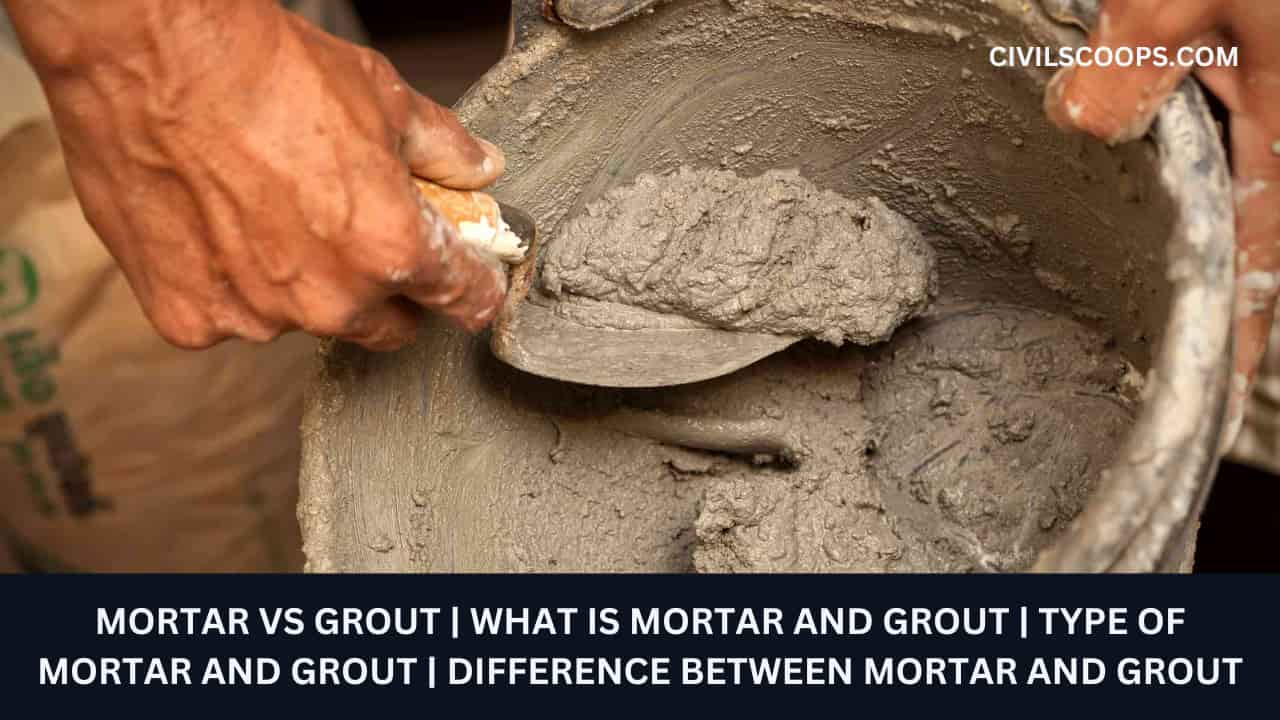
Table of Contents
What Is Mortar?
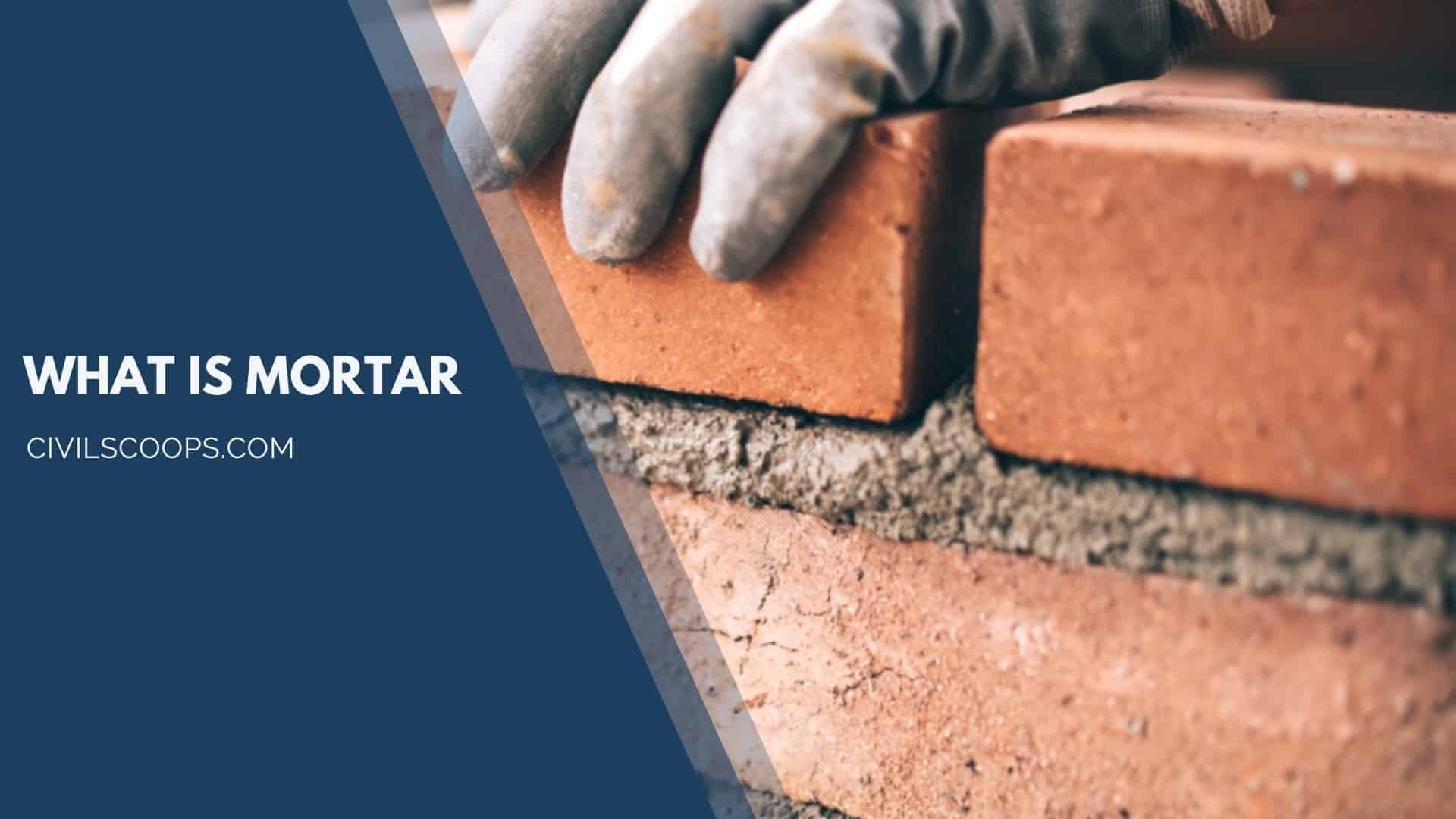
The term mortar is used to indicate a paste prepared by adding the required quantity of water into a mixture of binding material (cement or lime) and fine aggregate (sand).
The above two elements of mortar, namely, the binding material and fine aggregate, are sometimes referred to as the matrix and adulterant, respectively.
The matrix binds this particle of the adulterant. The durability, quality, and strength of mortar will mainly depend on the quantity and quality of the matrix.
The combined effect of the two components of mortar is that the mass can bind the bricks or stones firmly.
Classification/ Type of Mortar
The classification of mortars may be done in many ways, i.e., based on the binding agent, possessions of binding agent and aggregate, etc.
In general, mortars are classified as follows:
- Cement Mortar
- Lime Mortar
- Lime-Cement Mortar
- Special Mortar
1. Cement Mortar
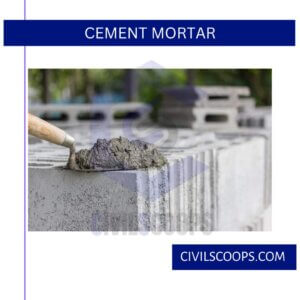
Cement mortar consists of cement as binding material, sand in different proportions, and water.
It’s the strongest type of mortar and is therefore preferred to be used in the construction of structures subjected to heavy loading.
2. Lime Mortar
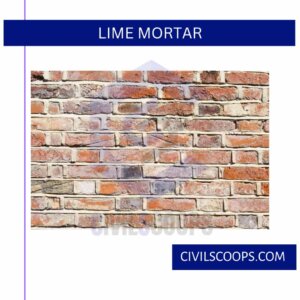
Lime mortar can be lime and sand mortar, lime, and surkhi mortar, sand, lime, and surkhi mortar, or lime and cinder mortar (also known as black mortar).
Lime used for mortar can be fat lime (quick or hydrated lime) or hydraulic lime.
Fat lime has a high calcium oxide content.
It’s hardening solely depends on the loss of water and absorption of carbon dioxide from this atmosphere and possible recrystallization in due course.
Hydrated lime is a dry powder obtained by treating quick lime with water enough to satisfy its chemical affinity for water under the conditions of its hydration.
Hydraulic lime contains small quantities of alumina and silica and/or iron oxide, which can be in chemical combination with a few calcium oxide contents, giving a putty or mortar that has the property of setting and hardening underwater.
Slaked fat lime is used to prepare mortar for plastering, whereas hydraulic lime is used in preparing mortar for masonry construction.
3. Lime-Cement Mortar
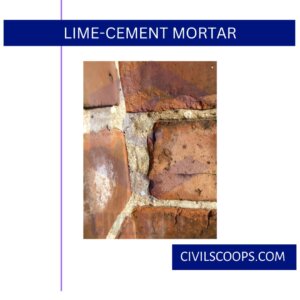
It’s also called composite mortar or gauged mortar. When lime mortar made from fat lime is desired to be improved with regard to its hydraulic properties, initial setting time, and strength, cement is added to it.
Cement should be added only to that much quantity of lime mortar, which can be used within an hour after the addition of cement.
4. Special Mortar

Following are the few special Kinds of mortars based on the binding material or certain specific characteristics:
- Mud mortar,
- Cement-clay mortar,
- Light and heavy mortars,
- Decorative mortars,
- Air-entrained (plasticized) mortar,
Test for Mortars
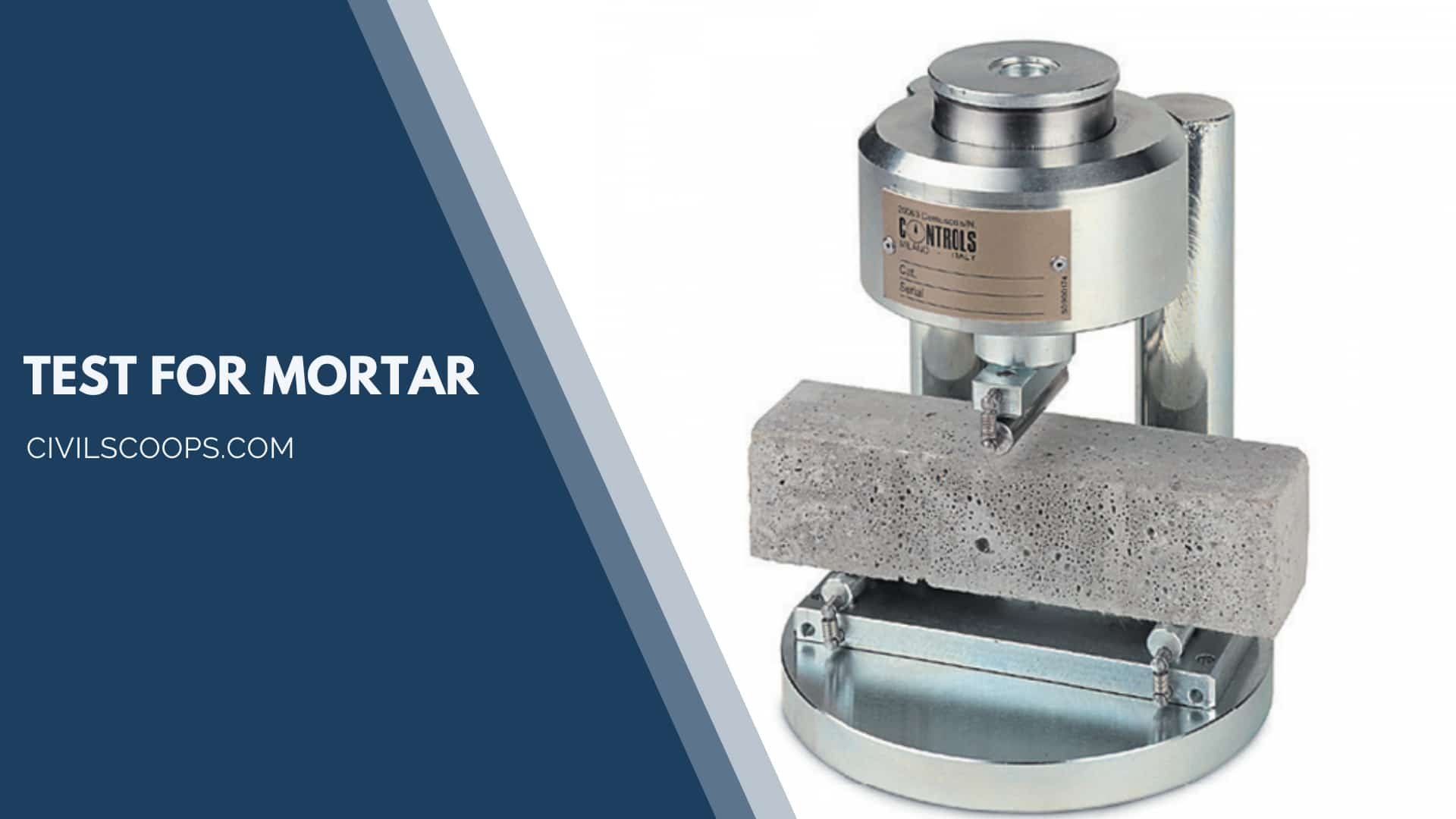
To test the quality of mortars, these can be subjected to several tests:
Crushing Strength
Adhesiveness
Cohesiveness or Tensile Strength
Test for Setting
What is Grout?
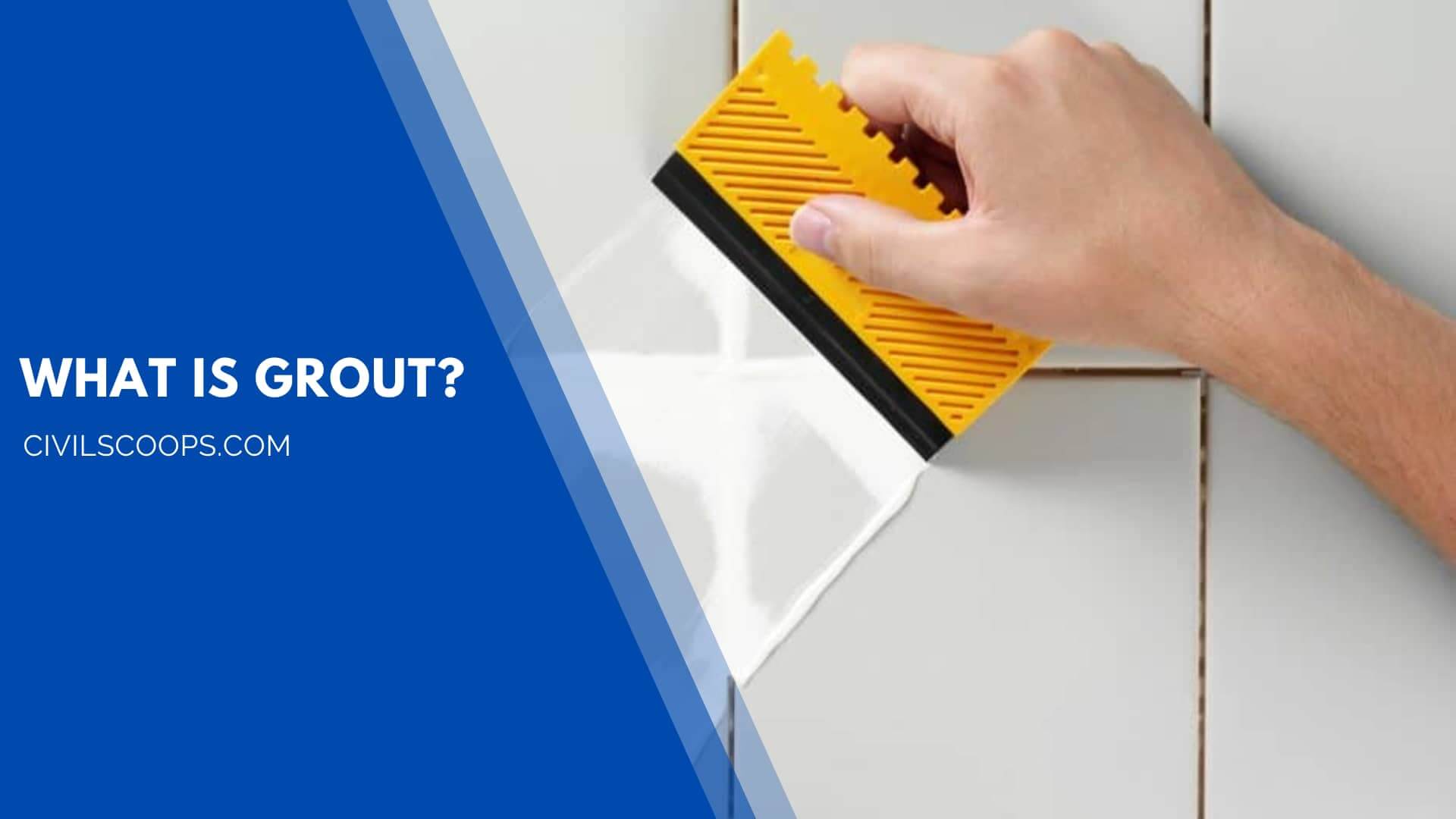
Grout is used to fill pints between tiles and is selected with a compatible mortar.
Grout is either a portland cement-based mixture or a mixture of other compounds to enhance its performance or ease its installation.
The type and size of tile, service level, climatic conditions, tile spacing, and individual manufacturer’s recommendations are factors that should be considered when selecting grout.
Portland cement-based grout is a mixture of portland cement and sand (for floors) or lime (for walls) and is used for thickset installations.
Portland cement-based grouts include commercial portland cement grout, sand portland cement grout, dry set grout, and latex portland cement grout.
Grouts based on mixtures of other compounds include solid epoxy, furan, silicone, and mastic grouts. Mastic grout eliminates the need for mixing on-site.
Epoxy grout is a two- or three-part mixture (epoxy resin hardener with silica sand filler) that is highly resistant to chemicals and has great bond strength. This grout and furan grout are made for different chemical and solvent resistance
Furan resin grout is a two-part furan mixture (similar to loran mortar) that resists high temperatures and solvents
Silicone rubber grout is an elastomeric mixture of silicone rubber. It has high bond strength, is resistant to water and staining, and remains flexible under freezing conditions.
Silicon, urethane, and modified polyvinyl chloride are used in pre-grouted ceramic tile sheets.
Silicone grout should not be used on kitchen countertops or other food preparation surfaces unless it meets the requirements of FDA Regulation No. 21, CFE 177.2600. Joint widths are only guidelines.
Individual grout manufacturers’ products may vary. Consult the manufacturer’s instructions.
Joint width is the only guideline. Individual grout manufacturers’ products may vary. Consult the manufacturer’s instructions.
Some types of glazed ceramic tiles, polished marble, marble agglomerates, and granite can be permanently scratched or damaged when grouted with sanded grout formulas.
Do not use sanded grout or add sand to grout when grouting polished marble, marbled agglomerates, and ceramic wall tiles with soft glazes.
Check the tile or marble manufacturer’s literature and test the grout on a separate sample area prior to grouting.
Some types of ceramic tiles and dimension stones may be permanently stained when grouted with pigmented grout of a contrasting color.
White grout is best suited for grouting white or light-colored marble or granite. Colored cementitious grouts may darken when wet.
Also Read: All About Sand | What Is Sand | 29 Types of Sand | Composition of Sand
Type of Grout
To test the quality of mortars, these can be subjected to several tests:
- Dry-Set Grout
- Latex Grout
- Silicone Rubber Grout
- Epoxy Grout
- Furan Resin Grout
1. Dry-Set Grout
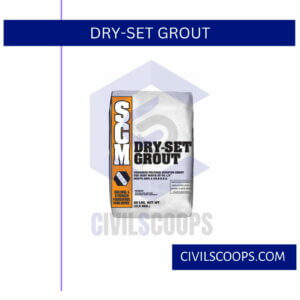
Dry-Set Grout is a prepared mixture of portland cement and sand, with additives to improve water retentivity.
Dry-set grout has the same properties as dry-set mortar and is suitable for grouting walls subject to ordinary use.
It eliminates soaking of tile, although dampening sometimes is desirable under very dry conditions.
2. Latex Grout
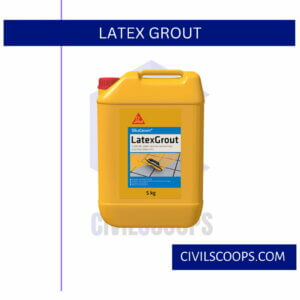
Latex grout is a mixture of one of the three preceding products, consisting mainly of portland cement with a latex additive to increase stain resistance and resilience of the joints.
Latex grout is suitable for installations subject to ordinary use.
It is less rigid and less water-permeable than sand-portland cement grout, allowing for more movement and greater exposure to moisture.
This grout, therefore, is particularly suitable for tub and shower areas.
3. Silicone Rubber Grout
![]()
Silicone rubber grout is an engineered elastomeric grout system for interior use employing a single-component nonslumping silicone rubber, which, upon curing, is resistant to staining, moisture, mildew, cracking, crazing, and shrinking.
It adheres tenaciously to ceramic tile, cures rapidly, and withstands exposure to moisture as well as subfreezing temperatures and hot, humid conditions.
4. Epoxy Grout

Epoxy grout is a two-part system consisting of an epoxy resin and a hardener.
It is made in several formulations, each intended for a specific ceramic tile.
It is highly stain-resistant and impervious and is used with epoxy mortar or epoxy adhesive.
Its use requires special skills and is usually expensive.
Epoxy grout is formulated without coarse fillers that might scratch glazed wall tile or mosaic tile.
It may be used on floors, walls, and counters subject to food staining.
It is also formulated with a coarse silica filler for use with quarry tile and pavers.
It is formulated for industrial and commercial installations where chemical resistance is of paramount importance.
It has excellent bonding characteristics.
5. Furan Resin Grout
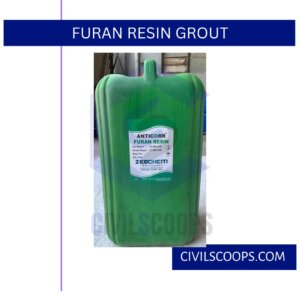
Furan resin grout is a two-part grout consisting of furan resin and a hardener.
It is intended for use with quarry tile and quarry tile and pavers, mainly in industrial areas requiring a maximum of chemical resistance.
It is generally used in conjunction with furan mortar.
| Sr.No. | Mortar | Grout |
| 1 | Mortar paste used in Cement, sand, lime, and water | Grout used in this material Cement, water and sand, epoxy, acrylic, and polymer |
| 2 | Water-Cement Ratio less | Water-Cement Ratio more |
| 3 | The cement mortar is to act as a binder in brick or stone masonry | The grout is to act as a filler material in tilling work and cracks. |
| 4 | Viscosity is low | Viscosity is highly viscous |
| 5 | In this mortar mix color of the cement | In this grouting in material colors as per the requirement |
| 6 | Type of Material. | Type of Material. |
|
Cement Mortar
Lime Mortar Lime-Cement Mortar Mud mortar, Cement-clay mortar, Light and heavy mortars, Decorative mortars, Air-entrained (plasticized) mortar, |
Dry-Set Grout
Latex Grout Silicone Rubber Grout Epoxy Grout Furan Resin Grout |
|
| 7 | This mortar requires curing for the hardening process | This grouting does not have extra water |
| 8 | Setting time isn’t less than compared to grout | Setting time isn’t more than compared to mortar |
| 9 | The mortar used in brick, stone, and concrete block joints, also used in plastering work | Grout as filler in cracks, Tiles grouting, the strength of grout. |
| 11 | It is stiffer | It is less stiff |
What Is Mortar in Construction?
Mortar is a mixture of sand and cement that is most often used to build brick or block walls. While that may sound like the same recipe used to make concrete, there are some intentional differences between the formulations for mortar and cement, which is why the materials should not be used interchangeably.
What Is Mortar Used for in Construction?
Mortar is a mixture of sand and cement that is most often used to build brick or block walls. While that may sound like the same recipe used to make concrete, there are some intentional differences between the formulations for mortar and cement, which is why the materials should not be used interchangeably.
Mortar
Mortar is a workable paste that hardens to bind building blocks such as stones, bricks, and concrete masonry units, to fill and seal the irregular gaps between them, spread the weight of them evenly, and sometimes add decorative colors or patterns to masonry walls
Using Dry Mortar Between Pavers
Mortar is spread bit by bit as the pavers are laid. So mortar is more conducive than concrete mix to the slow process of installing pavers. Also, dry mortar can be swept into the cracks between pavers; ambient moisture will cause the dry mortar to stiffen over time.
Mortar Mixture
The standard mortar mixing ratio is one part Portland cement to three parts sand. This varies depending on the type of mortar you need for your job. Add the sand to the concrete and use a mortar trowel or hoe to fold them together.
Lime Mortar Mix for Pointing
Mix dry, two parts sand (one soft, one sharp sand) with one part lime and add the final one part of soft sand on top. Being careful not to inhale the dust. Ensure the dry materials are evenly mixed prior to slowly adding water, mixing using hand tools to a smooth malleable consistency
Best Sand for Mortar
The best sand to use for rendering is coarse sand, which can give a smooth finish appropriate for most vernacular buildings. This type of sand holds even when the mix is a little richer in lime than a standard pointing mix
Type S Mortar Strength
Type S has high compressive strength (1800 psi) but adds high tensile bond strength. Type S mortars are required to have a minimum of 1800 psi and their mixes usually give you strengths ranging between 2300 and 3000 psi
Which Sand for Mortar
Mason sand is a smooth, fine sand that’s commonly used beneath swimming pools, masonry work, beaches, volleyball courts, sandboxes, pavers, and mortar
Non Hydraulic Lime Mortar
Non-hydraulic lime is made from pure limestone, and pure calcium carbonate, and tends to be in the form of putty. Non-hydraulic lime sets by carbonation (re-absorbing carbon dioxide from the air).
Type of Mortar for Brick
The masonry mortar is often used in brick, concrete block, and stone masonry construction; it is also used to produce stone plaster.
Sand and Cement Mortar
Mortar is composed of cement, fine sands, and lime; it is used as a binding material when building with brick, block, and stone. Concrete is a very strong structural building material composed of cement, sand, and larger aggregate (gravel)
Mixing Lime Mortar by Hand
- Start with an empty mixer.
- Add 1 part sand.
- Mix in 1 part lime.
- Followed by 1.5 parts sand.
- Mix dry for at least 5 minutes.
- After 5 minutes slowly add water until the desired consistency is reached, it is very important not to drown the mix by adding too much water.
Type N Mortar Strength
Type N mortar has a compressive strength of about 750 PSI, which is ideal for use with semi-soft stone or masonry applications. It’s more elastic than a high-strength mortar, which helps to prevent cracking and spalling of adjacent masonry units
Type M Mortar Strength
Type M mortar is the strongest of the four, and has a compressive strength of 2500 PSI. Type M mortar should be used when the structure has to withstand high gravity and/or lateral loads. Type M mortar is also a good choice for hard stone projects where the compressive strength of the stone is greater than 2500 PSI
Lime Mortar Brickwork
Hydraulic lime mortars are suitable for some modern masonry construction and are capable of producing sufficient strength and rate of setting for some thin wall brickwork applications.
Mortar Mix for Engineering Bricks
The standard ratio for average mortar mix is 3:1 or 4:1 for bricklaying. If you are using a pointing mix, then you should have a ratio of 1:4 or 1:5 mortar to sand. As for concrete, it depends on the strength you need it to be at. Usually, it is good practice to mix concrete at 1:2 mix to materials.
Type N and Type S Mortar
Type N mortar is a general-purpose mortar that provides good workability and serviceability. It is commonly used in interior walls, above-grade exterior walls under normal loading conditions, and in veneers. Type S mortar is used in structural load-bearing applications and for exterior applications at or below grade.
Mortar Mix for Edging Stones
Use 6 measures of small gravel (6 or 10mm) with 3 measures of sharp sand and 1 measure of Ordinary Portland Cement. These dry ingredients are thoroughly mixed together before adding water, a bit at a time until the mixture is damp throughout.
Different Types of Mortar
The 4 main types of mortar most commonly used are; Type N, M, S, and O. These types of mortar are thoroughly described in ASTM C 270, but we will briefly outline the characteristics and best use of each type here. Type N mortar is the most common type and is usually recommended on the exterior, above-grade walls.
Mortar Used in Brick Masonry
Lime mortar and cement mortar are two types of mortar generally used for brickwork.
Types of Lime Mortar
- Hydraulic Lime Mortar (Water Lime, Hydraulic) Made with Natural Hydraulic Lime (NHL). …
- Non-Hydraulic Lime Mortar (Air Lime, Non-Hydraulic) is Made with non-hydraulic lime, commonly known as lime putty. …
- Hot Mixed Lime Mortar (Air Lime, Non-Hydraulic)
Mortar Mix Uses
Mortar mix can be used for the construction and repair of brick, block, and stone for barbecues, pillars, walls, tuck-pointing mortar joints, and planters. We sell Quikrete Mortar Mix which is a blend of masonry cement and graded sand. You simply add water.
Type of Mortar for Slate Tile
Slate tiles differ slightly from other stone tile installations in that they require a wet-mortar bed made of a mixture of Portland cement and sand, rather than standard thin-set mortars. The typical ratio of cement to sand is 2 1/2 parts sand to every 1 part cement.
Mortar Mix Ingredients
If you mix cement with sand and water, it will form mortar. Or if you mix gravel and water it will form concrete. Mortar is made out of sand and water, some construction workers add lime into the mix too.
Type S Mortar for Pool Coping
Type N mortar is usually recommended on the exterior and above-grade walls (including stone veneer) that are exposed to severe weather and high heat. Type N mortar mix has a medium compressive strength and it is composed of 1 part Portland cement, 1 part lime, and 6 parts sand
Quikrete Mortar Temperature Range
The ideal placement temperature for QUIKRETE® concrete products is 70 ºF, but it may be placed at temperatures between 50 to 90 ºF. Below 50 ºF (but above 32 ºF), cold weather precautions must be taken to promote proper curing.
Making Mortar
Mix mortar from scratch by blending one part of Portland cement with three parts of sand. If you use a ready-mortar mix, the dry ingredients are already combined. Add one part water to three or four parts mix, depending on the type of job. Stir until mortar is smooth, typically 5-10 minutes.
Gauged Mortar
Gauged mortar is a type of mortar where cement and lime both are used as binding material and sand is used as fine aggregate. Basically, it is a lime mortar where cement is added to gain higher strength. The process is known as gauging. The cement lime proportion varies from 1:6 to 1:9.
Tensile Strength of Mortar
Tensile strength values are 101%, 102%, 107%, 109%, and 106% for slag mortar of replacement levels of 10%, 20%, 30%, 40%, and 50% for the curing age of 28 days. 60% and 70% replaced slag mortar achieved 85% and 70% strength of OPC mortar.
Flexural Strength of Mortar
The flexural strengths of the cast and printed specimens at a curing age of 28 days were 12.73 MPa to 14.49 MPa and 12.73 MPa to 14.49 MPa, respectively.
Flexural Strength of Cement Mortar
Flexural strength (sometimes called the modulus of rupture) is actually a measure of tensile strength in bending. PCC flexural strength testing is carried out on a 40 x 40 x 160 mm (1.57-inch x 1.57-inch x 6.30-inch) cement mortar beam. The beam is then loaded at its center point until failure.
Grout Lines
By definition, the grout line is the distance that separates one tile from another. Grout lines are necessary because this distance permits dilation of the floors and natural settling due to structural movements, humidity, and variations in temperature
Types of Grouting in Construction
- Cement Grouting.
- Chemical Grouting.
- Structural Grouting.
- Bentonite Grouting.
- Bituminous Grouting.
- Resin Grouting.
What Type of Grout to Use for Porcelain Tile
Sanded grout is recommended for any installation using ceramic, porcelain, granites, flamed or brushed marble, terrazzo, rock pebbles, or meshed pebbles with a 1/8″ or up grout joint.
Can You Use Vinyl Tile Grout on Ceramic Tile
Any vinyl tiles can be installed over existing tiles, as long as grout joints are flush on ceramic tiles. Installing them over other vinyl flooring isn’t a problem either as long as the existing vinyl is in decent shape.
What Type of Grout to Use
Sanded grout is the go-to choice for most interior flooring installations. This is because it is more durable than unsanded grout, can handle foot traffic, and is usable for larger tile joints
Type of Grout for Kitchen Backsplash
Unsanded grout is most often used on vertical surfaces, such as a kitchen backsplash. Since wall tile installations with narrow grout lines are less prone to cracking, the extra durability of sanded grout won’t matter
Different Types of Grouting Materials
Grout varieties include tiling grout, flooring grout, resin grout, non-shrink grout, structural grout, and thixotropic grout. There are a number of different types of grout and they each serve a purpose, which is analyzed below under divisions and sub-divisions.
Grout Type for Floor Tile
Sanded grout is the preferred grout for tile floors.
Like this post? Share it with your friends!
Suggested Read –
- All About Sand | What Is Sand | 29 Types of Sand | Composition of Sand
- 19 Different Types of Slabs in Construction | What Is a Slab | Types of Slabs
- All About Gypsum Plaster | What Is Gypsum Plaster | 15 Advantage of Gypsum Plaster | Disadvantage of Gypsum Plaster
- All About M Sand | What Is M Sand | Properties of Manufactured Sand | Advantages & Disadvantages of Manufactured Sand
- All About Uscs | Which Test Gives a Better Estimation of the Friction Angle | Introduction of USCS ( Unified Soil Classification System )